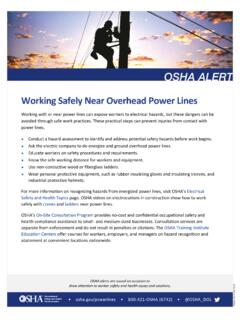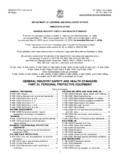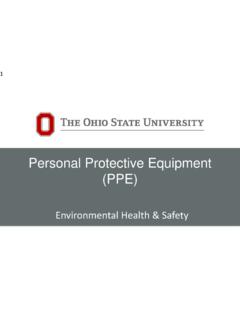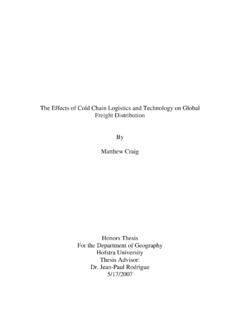Transcription of Sheet Metal - Occupational Safety and Health …
1 Sheet Metal Working with Sheet Metal requires attention to many Safety and Health issues. This chapter will address material handling of Sheet Metal , welding and cutting, and mechanical power presses. Additionally, it will reference other relevant chapters, including electrical Safety , lockout/tagout, material handling, back-injury prevention, and power and pneumatic tools. Material Handling of Sheet Metal Safe methods of handling Sheet Metal are not included in the material-handling regulations, which focus on material storage and safe use of slings, wire ropes, and cables on cranes and hoists. The safe handling of Sheet Metal as discussed here is directly related to the use of personal protective equipment (PPE) and back-injury prevention. Sheet Metal is heavy, and the edges and corners can be extremely sharp. Furthermore, Metal is an excellent conductor of electricity and heat and will become hot quickly if exposed to the sun or other heat sources. Likewise, Sheet Metal exposed to the elements of a winter s day may be cold, icy or wet.
2 For these reasons, it is essential that all employees working with Sheet Metal wear gloves that are made of leather or synthetic puncture-resistant material like Kevlar. Puncture-resistant sleeves that protect the forearm also are available. Appropriate eye protection is warranted in most instances where Sheet - Metal fabrication or installation take place. Back-injury prevention also is extremely important. Sheet Metal is awkward to carry it is difficult to grip, the sheets are substantial and it generally is cumbersome to carry or move. Whenever possible, Sheet Metal should be moved mechanically. If it must be moved manually, employees should practice proper lifting procedures and get assistance when needed. Sheet Metal should be stored on storage tables to minimize the amount of bending and lifting employees must do. Welding and Cutting Gas Welding and Cutting Gas welding or cutting involve the use of compressed gases to produce a high-temperature flame. Usually, a mixture of oxygen gas and some type of compressed gas as fuel acetylene is the most common combine to produce a very hot flame (over 4,000 F in many cases) that can weld metals together or cut metals.
3 Gas Cylinders Gas cylinders contain gas that has been compressed under extreme pressure to fit into a relatively small space. Any damage to the container can turn the cylinder into the equivalent of a bomb because the contents are volatile and under pressure. When handling compressed gas, employees must avoid bumping or otherwise disturbing the cylinders to prevent them from cracking or weakening. Hammers or pry bars never should be used to loosen valves or valve caps. Moving Cylinders Gas cylinders must remain upright when being stored, transported or used. Valve protection caps should be placed on all cylinders before they are moved unless the cylinders are transported in specifically designed carriers. The only time a cylinder is permitted to be in the other-than-vertical position is when it is being moved in the shop or on the work site or being hoisted to a different working level. When moving a cylinder within the shop or on the work site, it should be tipped and rolled on its bottom edge.
4 When it is being hoisted, the cylinder must be on a pallet, slingboard or cradle; it should never be lifted with a magnet nor should slings or chains be placed around valve assemblies or collars. When cylinders are in use, cylinder trucks, chains or other steadying devices must be used to keep the cylinders from falling over or knocking together. Storage Cylinders must be stored with care. Fuel-gas cylinders should always be separated from oxygen cylinders by at least 20 feet or by a noncombustible barrier. They must be stored in a dry and well-ventilated area, away from combustible materials, elevators, stairs and gangways, in a location where they cannot be bumped or damaged. Use When in use, cylinders must be kept a safe distance from sparks, hot slag or flames, and electrical circuits. A cylinder containing fuel gas, like acetylene, or oxygen must never be taken into a confined space (with the exception of self-contained breathing apparatus gear). Cracking It is the employer s responsibility to teach employees how to fuel gas safely.
5 One of the first things employees should learn how to do is crack a cylinder. Cracking is done to remove dust and dirt from a cylinder s valve and should be done before the regulator is attached. The proper method is to stand to one side and open the valve slightly, then close it immediately. The small amount of escaping gas will clear dust and debris from the valve so that it does not contaminate regulators or torch assemblies. Cylinders must never be cracked near any possible source of ignition. Opening Cylinders must be opened slowly to prevent damage to the regulator. To close the cylinder quickly, if need be, the regulator should be opened only about 11/2 turns. If a wrench is needed to open a cylinder, it must be left on top of the cylinder so it can be closed quickly. Nothing that can damage the regulator or prevent it from being turned off quickly should be set on top of the cylinder. When the time comes to remove the regulator, the cylinder valve first must be closed and the regulator bled of excess gas.
6 If any leaks cannot be stopped by tightening the gland nut (the nut that is attached to the valve stem) or applying the regulator, then the cylinder must be tagged and removed from the working area immediately. Manifolds Certain precautions must be taken when using manifolds. Manifolds must be placed in safe, well-ventilated and accessible locations and must bear the name of the substance they contain in letters at least 1 inch high, either painted on or otherwise permanently attached. Hose connections for oxygen and fuel must not be interchangeable, and header connections must be capped when not in use. Hoses Hoses for acetylene or other fuel gas must be clearly distinguishable from those for oxygen, either by color or texture. If hoses are taped together, at least 8 inches out of every 12 inches must be free from tape covering so that the color and texture can easily be seen. All hoses conducting substances that could ignite or combust must be inspected at the beginning of each shift and removed if they are in poor condition.
7 Hoses that look worn or damaged must be tested at twice their normal pressure, as long as the pressure is not less than 300 pounds per square inch (psi), to determine if they can still be used. Couplings for hoses must be the type that can only be disconnected with a rotary motion as opposed to a straight pull in order to prevent accidental disengagement or loose connections. Hose storage must be in well-ventilated areas, away from passageways, stairways and ladders. Torches At the beginning of each shift, torch valves, hose couplings and tip connections must be checked. Torches must be taken out of service if any part is defective. Cleaning wires, drills or other devices may be used to unclog torch tips if specifically designed for that purpose. Torches must never be lit with a match only with a friction lighter or other approved device and a burning torch must never be left unattended. See the chapter on fire prevention for more information on torch hazards. Additional Hazards Any part of equipment used in operations with oxygen must be kept away from oil and grease.
8 This equipment includes fittings, caps, valves, couplings, regulators, hoses and any other apparatus. Because pure oxygen can cause fire when it comes into contact with grease or oil, it should never be directed at oily surfaces or greasy clothes or put in any storage tank or vessel of fuel oil. Other welding hazards and technical instructions are specified in the American National Standards Institute (ANSI) regulation on welding, ANSI Arc Welding and Cutting Cables and Other Components Only fully insulated components may be used for arc welding. This includes the portion of the holder held by the operator; the outer surfaces of the jaws of the holder and all cables. The manual electrode holders must be designed specifically to handle the maximum-rated current required by the electrodes. Cables cannot be used if they need repair. They also cannot be used if they contain repairs or splices within 10 feet of the end of the cable to which the electrode is connected.
9 There are exceptions, however. If the splices still have insulating quality as good as that of the original cable, the cable may be used. It also is useable if the cable has standard insulating connectors. If splices anywhere on the cable are affected by cable lugs, they must be fastened securely for good conductivity and the Metal parts must be insulated. Grounding A grounded return cable must have a safe current-carrying capacity that is at least equal to the output capacity of the unit it serves. If it serves more than one unit, the capacity must be at least equal to the total maximum capacity of all units together. Unless it contains gases, flammable liquids or electrical circuits, a structure or pipeline may be used as a ground return circuit. The required electrical contact must exist at all joints, and the joints must be bonded and subject to periodic inspection if they are used continuously as a ground return circuit. The frames of all machines must be grounded through a third wire in the cable.
10 All ground connections must be inspected to make sure they are able to handle the current, mechanically and electrically. Operation Employers must train employees in the following arc-welding and cutting- Safety procedures: When electrode holders must be left unattended, the employee must remove the electrodes and place the holders in such a way that they cannot make electrical contact with people or objects. Hot electrode holders never should be placed in water because this may expose the operator to electric shock. The operator must open the power supply switch when he or she needs to leave the work or stop working for any significant amount of time. The operator must report faulty or defective equipment to a supervisor. Unless it is infeasible, all arc-welding and shielding operations must be shielded with a noncombustible or flame-proof screen to protect people in the vicinity. Fire Prevention for Gas and Arc-welding Operations Welding creates a number of fire hazards: heat, sparks, gases, slag and other emissions from the surface being welded or cut.


















